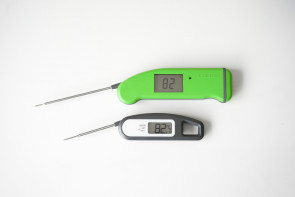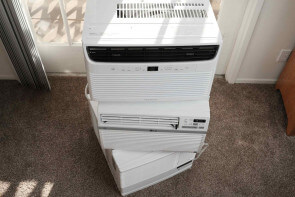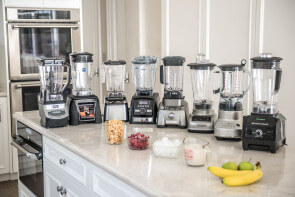
The Best Electric Smokers
Working with a professional chef, we tested five of the top electric smokers, smoking over 40 lbs of pork butt, 25 lbs of baby back ribs and 20 lbs of chicken. We found the Masterbuilt – 20071117 to be the best electric smoker overall, producing succulent, flavorful and tender smoked meats that could easily rival professional results. At nearly double the price, our runner-up is the Smokin’-It – Model #1 Electric Smoker.
Working with a professional chef, we tested five of the top electric smokers, smoking over 40 lbs of pork butt, 25 lbs of baby back ribs and 20 lbs of chicken. We found the Masterbuilt – 20071117 to be the best electric smoker overall, producing succulent, flavorful and tender smoked meats that could easily rival professional results. At nearly double the price, our runner-up is the Smokin’-It – Model #1 Electric Smoker.
Table of contents
- How we selected products to test
- Compare the best electric smokers
- Important features to consider
- How we tested
- Best overall: Masterbuilt – 20071117
- Runner-up: Smokin’-It – Model #1
- Other finalists we tested
- The bottom line
How we selected products to test
We began our research by reviewing the top-rated electric smokers on Amazon. From there, we compared those reviews with the recommendations made on dozens of online meat-smoking forums, such as The Smoke Ring, Smoked-Meat.com and SmokingPit.com. We also consulted with barbecue experts Jeff Phillips at Smoking-Meat.com, Steven Raichlen at Barbecue! Bible.com and Meathead Goldwyn at AmazingRibs.com to get pro tips on smoking.
The meat-smoking community is vast, the majority of which is based in the U.S. Midwest and South, and opinions are divided about electric smokers. Many barbecue professionals and enthusiasts profess that an electric smoker can’t give the finely balanced and nuanced smoke flavor that a charcoal grill can. However, they also admit that an electric smoker does indeed produce delicious food.
We refined our selection to the electric smokers that were durable, reliable, sturdily-constructed, easy to clean and user-friendly, especially for the beginner. We also gave extra points if the smoker’s manufacturer had a long-term warranty and helpful customer service.
Compare the best electric smokers
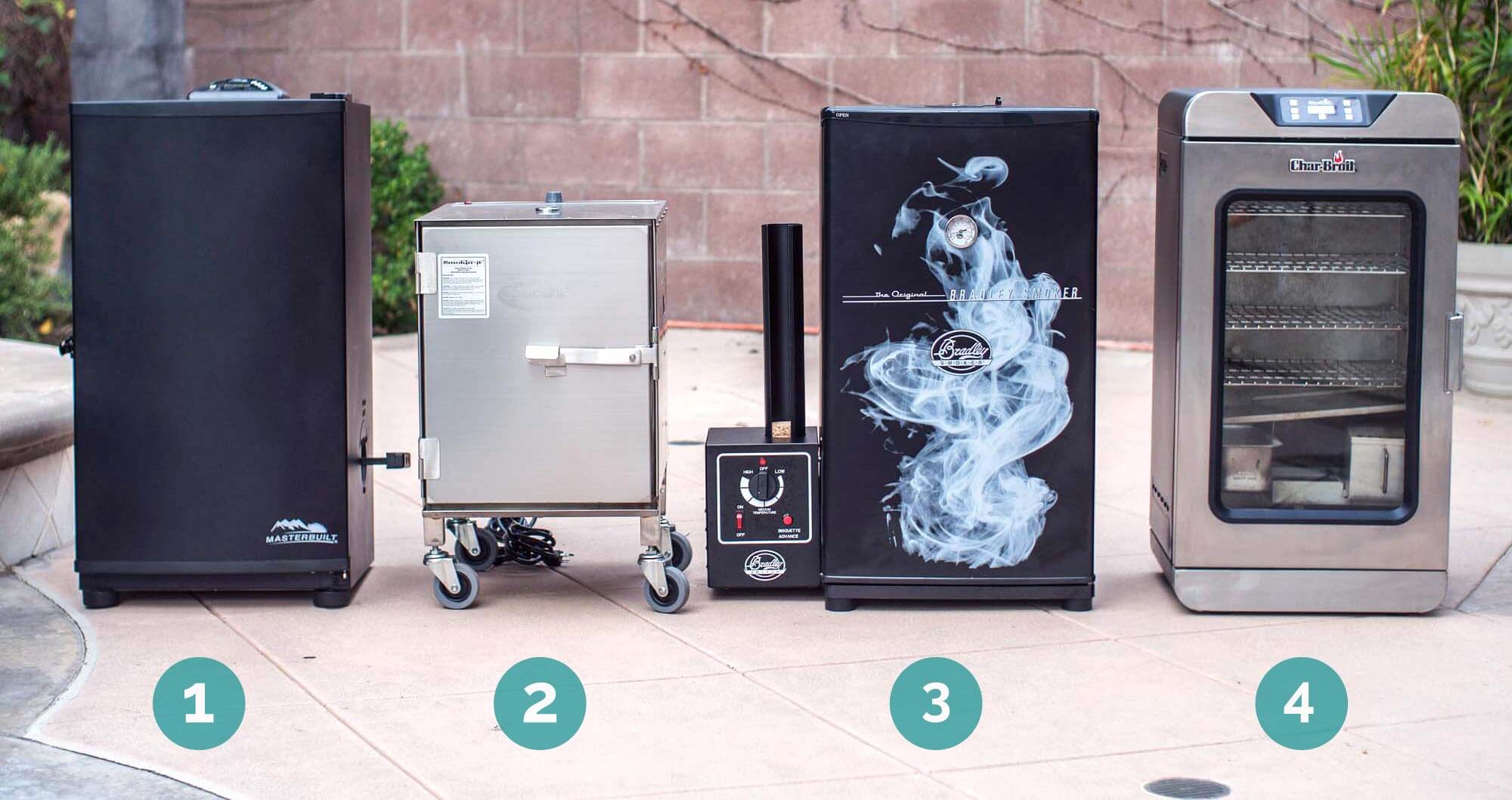
| Product | Price | Type | Smoke Source | Capacity (lb) | Ease of Use |
|---|---|---|---|---|---|
| 1. Masterbuilt - 20071117 | $$ | Digital | Wood chips | 40-50 | ☆☆☆☆☆ |
| 2. Smokin'-It - Model #1 | $$$$ | Analog | Wood chips | 20-30 | ☆☆☆☆☆ |
| 3. Bradley Original Smoker | $$$ | Analog | Bisquettes | 30-35 | ☆☆☆☆ |
| 4. Char-Broil - Deluxe Digital | $$$ | Digital | Wood chips | 40-50 | ☆☆☆ |
| 5. Smoke Hollow - 30162E (not recommended) | $$ | Analog | Wood chips | 40-50 | ☆ |
Types of electric smokers
There are four types of smokers you can buy: electric, charcoal, propane and wood pellets.
Charcoal smokers: The most commonly used smokers for enthusiasts and barbecue competitions are charcoal fueled. Charcoal smokers generally come in three shapes and sizes: an upright cabinet (like a mini-refrigerator), upright bullet (oval or egg-shaped) and horizontal (similar to a propane grill).
The charcoal slowly burns wood chunks or water-soaked wood chips, which are arranged around and on top of the charcoal. In a vertical smoker, the smoke is funneled upward to the meat; in a horizontal smoker, the smoke is funneled across the meat. These smokers require frequent maintenance of the charcoal during a typical four-hour smoking period to regulate heat and smoke.
Wood pellet smokers: These are horizontal electric smokers that are fueled by cylindrical wood pellets, which are automatically fed from a hopper into a burn pot. When the smoker is ignited, an electric rod in the bottom of the burn pot heats the pellets to smoking. Both the heat and smoke can be regulated so they are evenly distributed inside the smoker. Pellet smokers have increased in popularity, but they’re expensive.
Propane smokers: These are vertical, lightweight cabinets that are fueled by propane and are designed for easy portability to campsites. The propane fuels a burner that ignites wood chips or chunks to smoking. Heat and smoke can be regulated by adjusting how much propane flows from the propane tank. Propane smokers are relatively inexpensive, but their narrow size limits food capacity, and they generally perform poorly in cold or windy weather.
Electric smokers: These are built for beginners who want to smoke meats without the fuss of a charcoal smoker. Electric smokers are vertical cabinets with a heating element in the bottom of the cabinet. Wood chips are loaded into a vented metal box, which sits atop the heating element. The heating element is programmed to the desired temperature, which is automatically maintained by an internal thermostat. In the better models, the smoke can be regulated by a damper at the top of the cabinet.
How an electric smoker works
Electric smokers can be either analog or digital. Analog smokers are controlled by an on/off switch and a manual thermostat. Digital smokers are push-button on/off with a digitally programmed temperature setting. (Some have a digital timer as well.)
After the smoker has preheated, the wood chips are loaded, and they begin to smoke in about 15 minutes. The meat is then loaded onto the racks and the thermostat lowered for slow cooking. Depending on the weight and cut of the meat, this can take 90 minutes to three or four hours. The best electric smokers are well-insulated so when the door is locked, no smoke can escape except through a tube or damper at the top or side of the cabinet.
Wood chips smoke for approximately 30 minutes. Depending on how much smoke flavor you want, more chips can be added at intervals by opening the cabinet (in most cases, front-loading) and refilling the wood chip box.
The majority of electric smokers have a water bowl, which is filled to a prescribed level before the heating element is turned on. The water provides moisture inside the cabinet to prevent the meat from drying out as it smokes and cooks.
Some digital smokers have an internal meat probe (inserted when the meat is loaded onto the racks), which automatically shuts the smoker off when the meat’s programmed internal temperature is reached. If there is no internal meat probe, then the meat’s temperature needs to be checked manually to assure it is fully cooked.
How to smoke meat
The science of smoking meat
The method for preserving and flavoring meat by smoking dates back to the primitive era. All red meats are composed of muscle, fat and connective tissue, such as collagen. Some cuts have higher percentages of fat and connective tissue, so they need to be cooked at lower and slower temperatures for a longer period to dissolve and thus tenderize the meat.
If the animal’s muscle was exercised regularly – for example, the leg or thigh – there will be a higher content of connective tissue, which makes the meat tough. If less exercised – like the tenderloin – the meat will have less connective tissue and will need minimal cooking to be tender.
The gas chemicals released from hardwood smoking, combined with a low cooking temperature (between 225-250 °F), break down the meat’s connective tissue, As the fat and collagen dissolve, they moisten and tenderize the meat. It’s a technique that’s similar to braising, but smoking also creates a rich brown exterior layer, known as the Maillard Reaction, cherished by meat-smoking enthusiasts.
The interior pink layer beneath the browned surface of smoked meats is known as the smoke ring, which is a result of the wood’s released gasses binding with the meat’s water composition. This chemical reaction creates a pink ring, usually ¼-inch deep, that indicates the smoke has penetrated the meat. In the barbecue world, achieving that perfect pink ring just beneath the crusty “bark” (exterior) of smoked meat is considered the hallmark of a barbecue master.
Types of wood

The rule of thumb for what woods to use for smoking meat is that it should be a hardwood, like oak, apple or maple. Any conifer, such as pine, redwood or cedar, should be avoided, since they release toxins when heated, and the smoke can taint the meat.
Fruit and nut tree woods add a mild and sweet flavor and are great for chicken and fish. Hardier woods, such as hickory and mesquite, produce bold and rich flavors, so you want to use a meat that can hold up to their strong smokiness, like beef and lamb.
Hickory is used most often for smoking bacon. It’s an aggressive flavor that you might not want for a loin or chop. Smoking forums recommend nut and fruit woods, such as pecan or pear, which give a milder smoke flavor to chicken and pork.
You could also try blending different woods; for example 70 percent apple wood with 30 percent mesquite. When it comes down to it, you can experiment and dictate the smoke’s flavor to your personal taste.
Wood chips v. bisquettes
The wood used for electric smokers can be either wood chips or bisquettes. They are available in an extensive variety of hardwoods.

Wood chips
The majority of electric smokers on the market use wood chips, which are readily available online or in hardware and barbecue stores. A small portion of wood chips is loaded into the smoker’s wood-chip box, which is set on top of the heating element.
Overall the smokers we tested use dry wood chips only. The Masterbuilt, however, allows you the choice of either dry chips – for an intense smoke and flavor – or soaked chips – for less smoke and a lighter flavor. After about 30 minutes, the wood chips cease smoking and burn to black shards or ash. If you want more smoke flavor, you would add another portion of chips, and continue to do so until the meat is fully cooked.

Bisquettes
The Bradley Original Smoker is one of the few electric smokers that uses bisquettes, which are discs about two inches in diameter and one-half-inch thick, composed primarily of compactly pressed sawdust. The bisquettes burn for approximately 20 minutes, and they produce a milder smoke than wood chips.
Bradley Smoker is the only manufacturer of the bisquettes (the method is a closely guarded secret), and they sell plain hardwoods and hardwoods flavored with herbs or beer.
Bisquettes are more expensive than wood chips, and several smoking forums and videos will instruct you on how to make your own. It’s an involved process that requires woodworking skills, but the forum contributors claim that their DIY bisquettes cost pennies and burn the same as the Bradley Smoker bisquettes.
Important features to consider
Digital vs. analog: Two of the five smokers we tested were digital – Masterbuilt and Char-Broil – and they were the easiest to program temperature and time settings. There is a slight difference in price between the digital and analog models, but paying more for a digital model for its ease in programming is worth it.
An exception is the Smokin’-It #1, which is nearly twice the price of our top pick, the Masterbuilt, but it stands out as a superior analog model.
Cabinet material: The cabinets of the two best-performing models, Masterbuilt and Smokin’-It #1, are made of reinforced high-grade stainless steel, which proved very effective in retaining smoke and moisture and were much easier to clean than the other smokers made of lower-grade steel.
Door lock and seal: The rubber gasket lining the smoker door isn’t enough for sealing the door. A strong lock is essential for heat and smoke retention, and each of the smokers we tested had a different type with a wide variance of effectiveness.
Smokin’-It #1 doesn’t have any gasket, but its heavy-duty latch system uses a compression fit that tightly seals the door. We experienced the worst smoke leakage with the Smoke Hollow – 30162E, which had a thin gasket and a small, weak latch that barely held the cabinet door shut.
Internal meat probe: The Char-Broil was the only smoker we tested that had a built-in programmable meat probe, and it was accurate in gauging the meat’s internal temperature. For the other smokers we needed to manually check the meat’s internal temperature at intervals. Remote control meat probes are not expensive, so we recommend purchasing one if it is not included in the smoker.
How we tested
Seasoning the smoker
Before testing could begin, we needed to “season” the electric smokers. In this case, seasoning doesn’t mean applying herbs and spices to the meat. It’s a preliminary preheating of the smoker that burns off any residue from manufacturing, packing and shipping. Because there are potentially toxic substances, such as paint and machine oil, clinging to the inner cabinet’s walls, it’s essential to season your smoker before you smoke any food.
When seasoning a cast iron skillet, you apply a thin coat of oil and then heat the skillet in a hot oven. The oil bakes into the skillet and leaves a protective coating, which then allows you to simply wipe the skillet clean without soap and water.
The same principle applies to seasoning an electric smoker. It’s a simple process. The smoker is heated to 275 °F for three hours, and wood chips are inserted for the last 45 minutes.
Other cooks on forums advise applying a thin coat of oil to the inner cabinet’s walls, which, after heating, leaves a protective finish. However, except for the Smoke Hollow, instruction manuals for the smokers we tested did not recommend oiling their cabinets before heating.
We followed Smoke Hollow’s manual and seasoned the cabinet with canola oil. After we completing our testing, we discovered that the cabinet was permanently stained and impossible to clean.
Choosing the meats to smoke

We wanted to smoke meats that represented the most popular types and cuts people cook, so we could get a good feel for results with each machine.
Beef brisket and pork ribs are undoubtedly the most popular meats that people smoke. Brisket, however, is considered something of an art form in barbecue. The cut and quality of the brisket, its preparation, smoking time and whether the smoker is fueled by wood, charcoal or propane affect the quality of the finished smoked meat.
Pork ribs, pork butt (for pulled pork) and chicken need less preparation and minimal attendance during smoking, which would allow us to continually monitor how well or poorly the smoker was functioning.
Dry rub recipes

Debates rage among BBQ cooks and enthusiasts about when and if to slather a wet sauce (or mop) over ribs or chickens before and during smoking. We decided that a wet sauce would disguise how each of the smokers flavored the meats, so we opted for a dry rub.
Similar to a marinade, a dry rub needs to be applied several hours – if not a full night – before you smoke the meats. A major component of a dry rub is salt, which penetrates deeper than a marinade does and intensely flavors the interior of the meat the longer you keep it on.
We scoured online forums for the best dry-rub recipes for pork butt, pork ribs and chicken. They all have ingredients in common – salt, pepper, paprika, sugar and garlic – but they differ in proportions. Paprika adds almost no discernible flavor and simply colors the meats the beautiful burnished brown desired by meat-smoking enthusiasts.
We used the following dry rub recipes for our testing:
U.S.D.A. recommendations
Since smoking involves cooking meats at low temperatures, the U.S. Department of Agriculture advises certain precautions for avoiding illness from food contamination, which we adhered to during our testing.
- Thaw meat in the refrigerator, never at room temperature.
- Once the meat is thawed, apply the dry rub and let it marinate in the refrigerator, never on the counter.
- Use two thermometers when smoking meats, one for the smoker itself and the second for monitoring the meat’s internal temperature. All of the smokers we tested had thermostats, but we also used an oven thermometer to compare the accuracy of the smokers’ thermostats. We maintained the smoker temperature at 225-240 °F. (The U.S.D.A advises no lower than 225 °F.)
- Cook pork to the internal temperature of 145 °F and chicken to 165 °F. We frequently checked internal temperatures with an instant-read thermometer.
Texture and flavor
We followed the U.S.D.A. recommendations for internal temperatures, and the chicken was fully cooked in 90 minutes, the pork ribs in two hours and the pork butt in three to three-and-one-half hours. Next, we let the chicken and pork ribs rest 30 minutes and the pork butt 45 minutes before slicing so the juices could be reabsorbed into the meat.
Overall, the chicken was the most successful. Each of the smokers produced a well-seasoned, tender and juicy chicken with a crisp and richly browned skin. We smoked the chicken with applewood, and generally, the smoke flavor was light. Smokin’-It’s chicken was exceedingly juicy, but the skin had a strong smoke flavor, which we didn’t find appealing.
We had mixed results with the pork ribs and pork butt. All the smokers gave us flavorful and nicely smoked pork, but tenderness and juiciness were inconsistent. The Masterbuilt and Smokin’-It gave us the best pork butt, and Smokin’-It’s ribs were superior to the rest.
Cleanup
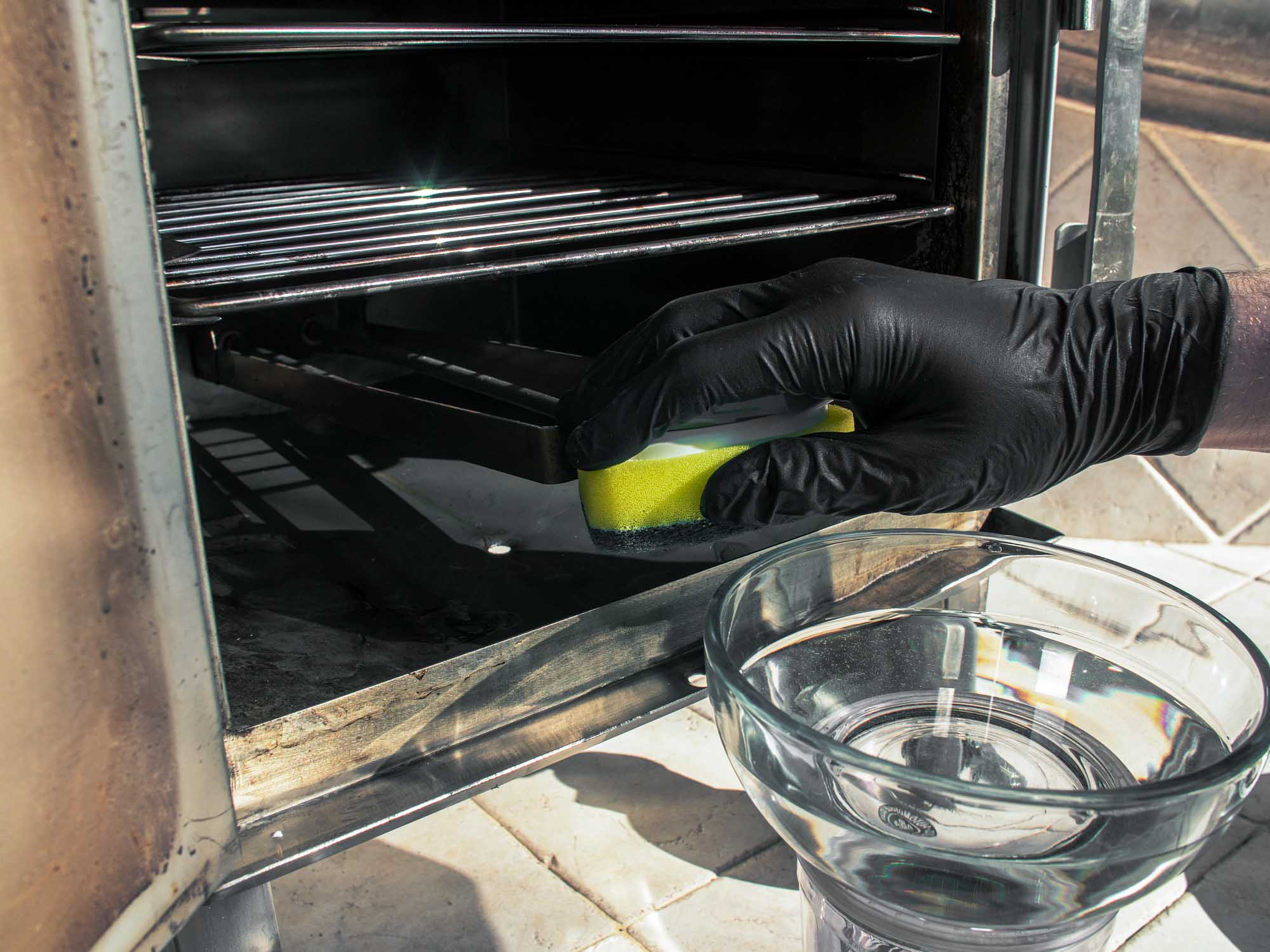
During the smoking and cooking process, the meat’s fats and connective tissue melt and splatter inside the smoker’s cabinet and onto the racks, drip pan, wood-chip holder and water bowl. The grease – deeply colored by the dry rub sugar and seasonings – and the soot produced by the burning wood stain the smoker. Smoker enthusiasts often refer to this stain as the “patina.” Even with proper curing, your smoker will never look like new again.
Manufacturers advise simply wiping the smokers down with paper towels, but we did not find this was the most effective way to clean the baked-on grease and soot. Cleaning products are too abrasive and can destroy the smoker’s “patina”, so after some research, we found the best cleaner to be a 50-50 solution of distilled vinegar and water.
Masterbuilt’s reinforced, high-gauge stainless steel prevented staining and the vinegar-water solution was effective in dissolving the greasy splatter. The smoke slightly burnished the cabinet, but in this case, it actually was a patina. Smokin’-It had minor staining, but it was also very easy to clean.
Best overall: Masterbuilt – 20071117
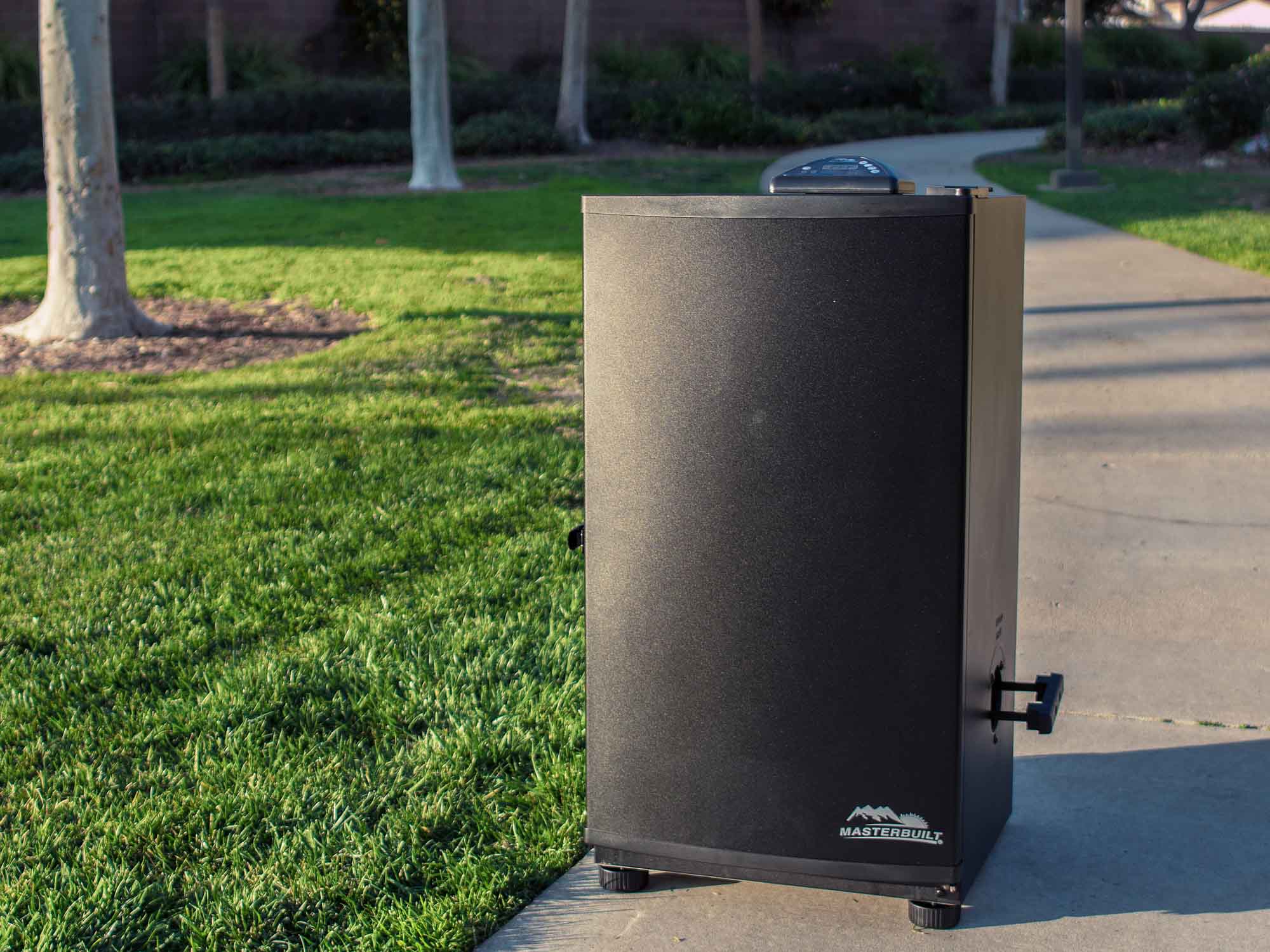
For convenience, ease of use and consistent results, we recommend the Masterbuilt – 20071117 as the best electric smoker overall. Right out of the box, we knew we had a winner. The smoker cabinet is well-constructed and sturdy, and the few pieces that needed to be installed – cabinet feet, digital read-out, shelves, water bowl and drip-pan – were individually and meticulously packaged. The assembly was a snap, taking all of 15 minutes.
The Masterbuilt comes with four chrome-plated shelves (approximately 14 inches by 16 inches each), which, according to their website, can hold a total of 80 pounds of meat. However, the internal cooking space of the cabinet is 721 square inches and can realistically fit only 40 pounds of meat. We do not recommend crowding more than 40 pounds since it could hinder both cooking and smoking.
As with all the smokers, the Masterbuilt needed to be seasoned by heating the cabinet to 275 °F for three hours. The digital display is user-friendly, and setting the temperature and timer are simple. We tested the accuracy of all the smokers with an oven thermometer, and the Masterbuilt’s built-in thermostat was on-the-nose accurate.
The smoker has a patented side-loading wood chip feeder, which allows you to add more chips without opening the cabinet’s front door and releasing heat and smoke. The wood chips (only ½ cup) are placed in the loader, which you then insert into a hole near the bottom of the cabinet. With a slight twist of the wrist, the loader dumps the chips into a tray on top of the heating element, and they begin to smoke within 15 minutes.
The chips stop smoking after about 45 minutes, which was enough time to thoroughly smoke and flavor chicken and pork ribs. (Cooking took another 45 minutes.) The pork butt needed double the time to smoke, so for the butt, we loaded an additional ½ cup of chips half-way through the three-hour smoking time. The loader only holds ½ cup of wood chips, so if you prefer a more smoked meat, you can add chips each time the prior load stops smoking.
All of the meats we smoked were beautifully browned, lightly smoked and delicious. What set the Masterbuilt apart from the others, however, is the exceptional moistness and tenderness of the smoked meats, especially the pork butt, which could be sliced as a juicy roast or easily shredded for pulled pork.
Cleaning the smoker couldn’t be easier. Due to the reinforced high-gauge stainless steel cabinet, smoke and grease didn’t stain it as deeply and permanently as they did with the other smokers.
Finally, the Masterbuilt is very affordable. The current price on Amazon as of this writing puts the Masterbuilt considerably lower than the other smokers we tested and just a few dollars higher than the much inferior Smoke Hollow. For such a superior product, the Masterbuilt’s value simply cannot be beat.
Key takeaways:
- The Masterbuilt – 20071117 is an incredible value for its many features, such as user-friendly digital programming, a perfectly calibrated internal thermostat and evenly distributed heating.
- Its patented side-loading chip feeder allows you to add wood chips without opening the cabinet door and releasing heat and smoke.
- The Masterbuilt was the only electric smoker we tested that gave us consistently tender and juicy meats with well-balanced smoke flavor.
- The cabinet’s 720-square-inch interior allows you to smoke 40 pounds of meat at one time.
- Its high-grade stainless steel cabinet prevents permanent staining and is easy to clean and maintain.
Runner-up: Smokin’-It – Model #1

Our runner up, the Smokin’-It – Model #1, is the smallest model of the Smokin’-It electric smokers, which are known for their high-end construction, thoughtful design and features that no other electric smokers have, such as a compression-fit door latch and heavy-duty casters, sturdy side handles and extra-long 12-foot power cord for easy portability.
As with the Masterbuilt, the Smokin’-It #1 needed virtually no assembly, and once the casters and interior parts were installed, it was ready to be seasoned with the hickory blocks that were included with the smoker.
The Smokin’-It #1 is a 13”x17”x12” box, entirely made of heavy-gauge stainless steel. Although its internal capacity (468 square inches) is less than the other smokers we tested, there’s still plenty of space to smoke a couple of chickens or a medium-size turkey.
The wood-chip housing slides over the heating element, which evenly distributes the chips across the depth of the cabinet. The efficient rheostat accurately heats the smoker up to 250 °F, and the heavy-duty latch system securely seals the smoker’s door by a compression fit so there is no dissipation of heat or smoke.
Although there are virtually no instructions for operation included, you can find plenty of information on Smokin’-It’s website. One suggestion is to line the smoker with foil for easier clean-up. This was unusual advice, since other smokers warned that doing so could cause irregular heating. The foil, however, had no effect on how the Smokin’-It distributed heat in our testing, and cleaning up afterward was indeed a cinch.
Unlike the other smokers we tested, a water tray isn’t required. According to the Smokin’-It forum, the cabinet is 90-percent air-tight, which substantially diminishes the meat’s natural moisture from evaporating. We were skeptical, but both the chicken and pork butt were exceedingly juicy and the baby back ribs were the best of all the ribs we smoked in the other smokers.
The Smokin’-It #1 is certainly a quality product, but it’s $170 more than our top pick, the Masterbuilt – 20071117. However, the company’s three-year warranty for parts and workmanship and the smoker’s unique certification by NSF International for commercial kitchen use could be incentives for spending more for this electric smoker.
Key takeaways:
- Sturdily constructed of high-gauge stainless steel with a compression-fit door seal, Smokin’-It #1, is the only electric smoker to be NSF-certified for commercial kitchen use.
- It’s compact design, sturdy side handles, heavy-duty casters and 12-foot power cord allow for easy mobility, even to campsites where an electrical outlet is available.
- The Smokin’-It is more expensive than other smokers, but its high-end craftsmanship and a unique three-year warranty for parts and labor are worth the price.
Other finalists we tested
Bradley Smoker – BTIS1 Original Smoker

Since our review, Bradley made a minor change to their BTIS1 model by moving a heat control knob from the door to the generator panel. But other than that the Bradley Original Smoker – BS601 is exactly the same. The Bradley performed well, but as we noted earlier, it uses compressed-sawdust bisquettes, which can be costly, considering how many the smoker burns through in one smoke session.
The Bradley is different from the other smokers in that the smoke generator and the main cabinet are not integrated and are joined together by two power cords. Initially, the cabinet wasn’t heating properly, so we contacted the company’s excellent customer service who helped resolve the issue by advising us to simply “jam in” the power cords. (We did, and it worked!)
The bisquettes are automatically advanced through a feed hole from the smoke generator into the cabinet one at a time every 20 minutes. As the next bisquette pushes through, the charred remains of the previous bisquette fall into a water bowl. The generator reliably advanced the bisquettes, but during our testing, the charred bisquettes backed up and spilled over the water bowl onto the drip pan.
The generator also controls regulation of heat, and although the thermostat registers 300 °F, even turned up high, the smoker struggled to hit 250 °F.
Ribs smoked in the Bradley were alternately dry and moist, but both the pork butt and chicken were evenly cooked, juicy and lightly smoked. However, whereas the Bradley’s pork butt sliced beautifully as a roast, it wasn’t as shreddable for pulled pork as it had been in the Masterbuilt and Smokin’-It tests.
The Bradley’s internal cabinet is lined with polished chrome, and from the middle of the cabinet upward, it was relatively easy to clean and restore its mirror-like sheen. The bottom half of the cabinet, however, was stained by smoke, which could not be removed.
Char-Broil – Deluxe Digital
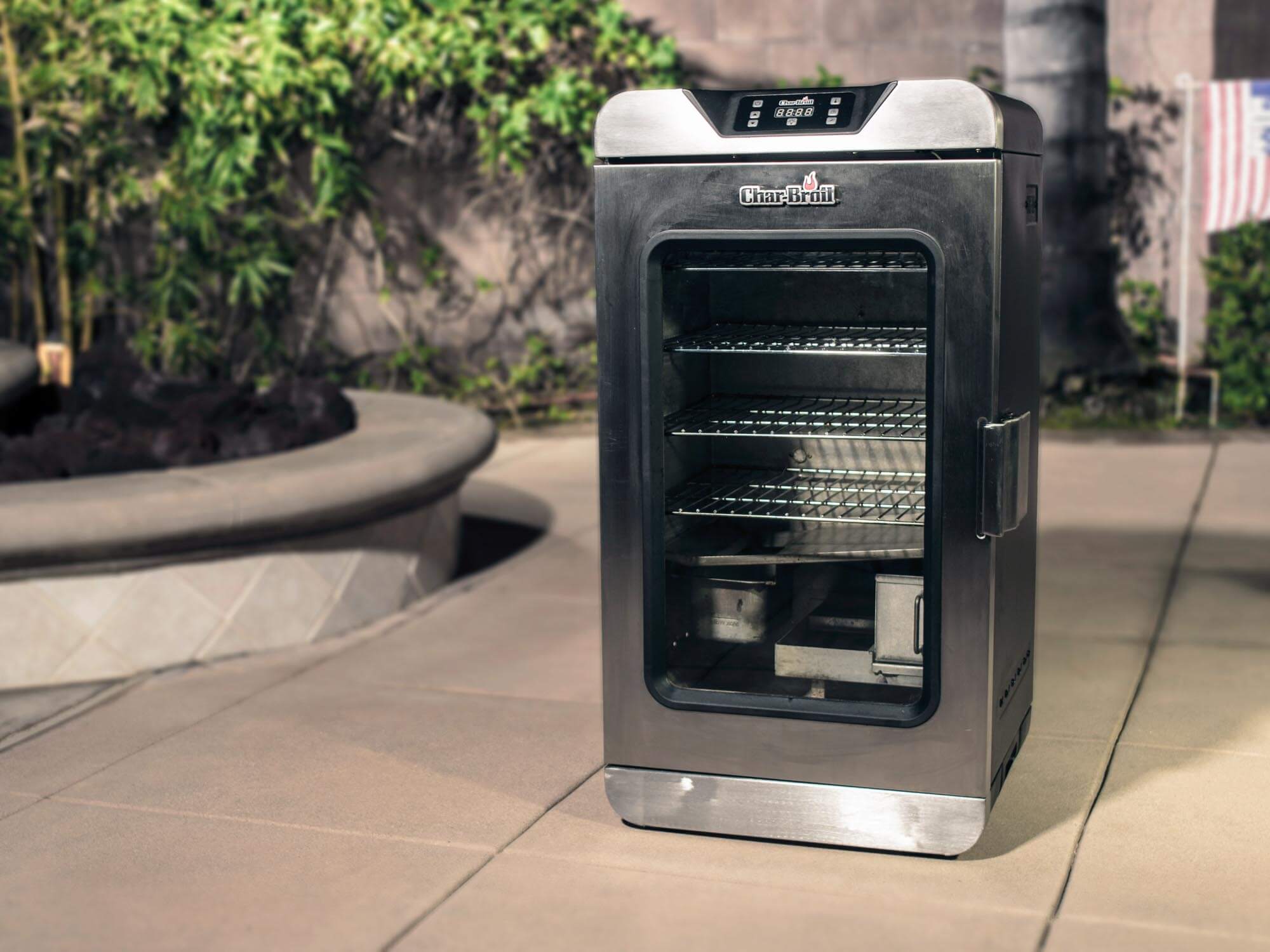
We got mixed results from the Char-Broil – Deluxe Digital. It’s equipped with some great features, such as a digital timer, thermostat, remote control and internal meat probe, The meat probe, in particular, as we noted above, is especially handy, since you can program the smoker to shut off when the meat reaches the desired internal temperature. We double-checked internal temperatures with an instant-read thermometer, and the Char-Broil was always accurate.
The instruction manual advises how much to fill the wood-chip box for smoking time. For example, one-quarter filled for two-to-four hours, which did not prove accurate since the chips were blackened shards that had ceased smoking after 90 minutes.
The Char-Broil produced beautifully colored and nicely smoked chicken, but both the pork butt and ribs were chewy. We resorted to wrapping them in foil and cooking them longer to achieve the results we got from the other smokers we tested.
Clean-up was challenging and messy. The removable pieces can be soaked in hot soapy water, but the cabinet and tempered-glass door are difficult to clean without using harsh cleaners and a lot of elbow grease.
Smoke Hollow – 30162E

The Smoke Hollow – 30162E was trouble from the get-go. First, it needed to be completely assembled, which was difficult due to improperly bored holes and bolts pre-tightened too tightly. The puny door latch couldn’t sufficiently seal the cabinet, so smoke seeped out throughout the smoking process.
During our tests, black greasy liquid dripped from the bottom corners. We inspected the cabinet and discovered its inner aluminum lining had buckled, another factor attesting to the smoker’s shoddy build.
The Smoke Hollow’s temperature regulator is erratic, and since the smoker’s flimsy temperature gauge broke early on, we needed to manually monitor the cabinet throughout the smoking process to ensure a low temperature was maintained.
As to results, the chicken and ribs had good smoked flavor, but were dry. The pork butt could be sliced, but even after four hours, it was still not tender enough to shred for pulled pork.
Clean-up was even more challenging that it had been for the Char-Broil, especially in the corners where the black grease had collected underneath the cabinet’s buckled lining.
After our tests, we thought we might have received a dud or it had been damaged in shipping, but we re-reviewed comments on Amazon and saw many customers experienced the same issues we had with the Smoke Hollow that they had purchased.
Smoke Hollow is slightly less expensive than the other smokers we tested, but it’s cheaply made and not worth the price.
The bottom line
Hardline barbecuers probably aren’t going to change their opinion of electric smokers. But for the rest of us, electric smokers really do give great smoked meats that a professional might be hard-pressed to challenge.
In our opinion, the most reliable, durable and best-value electric smoker is the Masterbuilt – 20071117, which will give you evenly smoked and cooked meats that are mouth-watering, succulent and delicious. Its numerous features – user-friendly digital programming, accurate thermostat, patented side-loading chip feeder – put the Masterbuilt ahead of the other smokers we tested.
If you want to spend a bit more money on a high-quality smoker, then we recommend Smokin’-It #1. It’s the only electric smoker that’s been NSF-certified for commercial kitchen use, and the manufacturer’s three-year warranty for parts and workmanship simply can’t be beat.
More Reviews
The 8 Best Electric Egg Cookers
Elite Gourmet - EGC-007B
The 8 Best Salt and Pepper Grinders
Merazi Living
Blue Apron
Martha & Marley Spoon
HelloFresh Meal Delivery Kit Review
HelloFresh
The Best Window Air Conditioners
Frigidaire - FFRE0833U1
Cuisinart - CBT-2000














